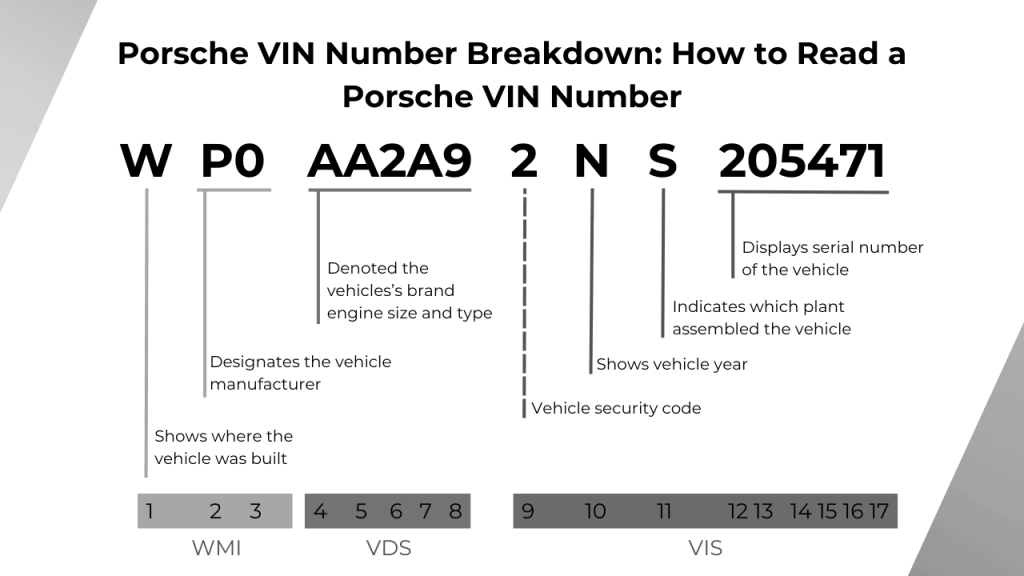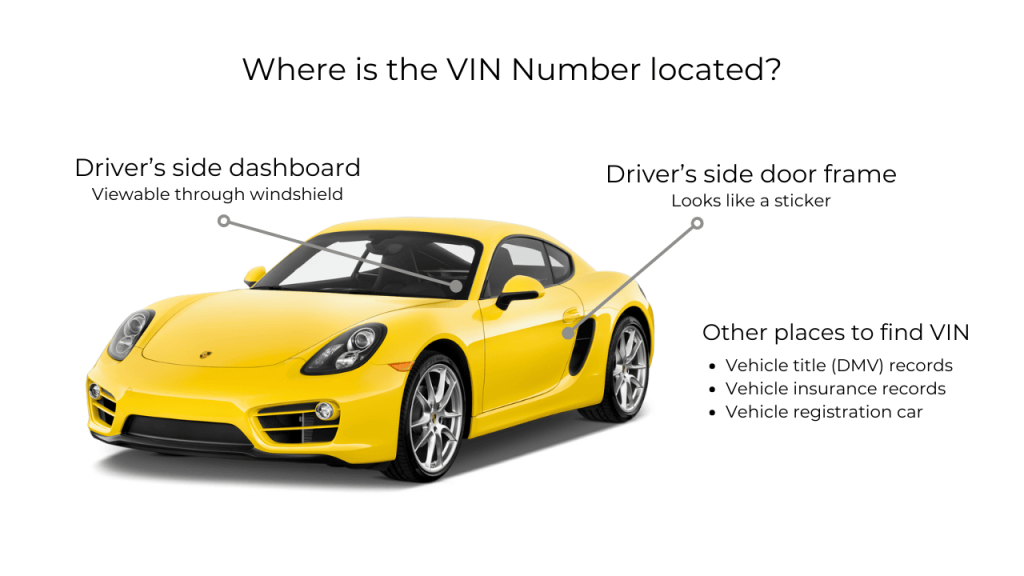Porsche VIN Decoder
When buying a used Porsche, you may be making a huge mistake by relying only on what the seller tells you. By entering the VIN into our Porsche VIN decoder, you can easily verify the original specifications like year, make, model, trim, transmission, engine, and even the history.
What is a Porsche VIN Decoder?
A Porsche VIN decoder helps break down the 17 characters of the VIN to reval important information, including the car’s production year, model, engine type, and manufacturing plant.
Decoding your Porsche VIN is crucial for verifying the vehicle’s history, checking for recalls, confirming specifications, and ensuring accurate maintenance. It’s an important tool for buyers, sellers, and owners to make informed and confident decisions during a vehicle transaction.
How to Read a Porsche VIN Number?

Note that the letters I, O, and Q are not included in a VIN to avoid confusion with the numbers 1 (One), 0 (Zero), and 9 (Nine).
Each digit of the 17-digit characters provides information about Porsche’s specific details. These characters are also grouped into three sections to make decoding easier, they are:
- World Manufacturer Identifier (WMI): This includes the first three characters (characters 1 – 3) and signifies the vehicle’s country of origin and manufacturer.
- Vehicle Descriptor Section (VDS): This section includes the 4th to 8th characters (characters 4 – 8) and contains information about the vehicle’s make, engine specs, model, and more.
- Vehicle Identifier Section (VIS): Here, you will find the 9th to 17th characters (characters 9 – 17), which encode details like the model year, manufacturing plant code, and a serial number unique to each vehicle.
What Does Each Character of the VIN Mean?
In this section, we will break down each character of the VIN using a 2008 Porsche 911 VIN: WP0AC299X8S792067 as an example:
| Position | Number | Position | Number |
| 1st | W | 10th | 8 |
| 2nd | P | 11th | S |
| 3rd | 0 | 12th | 7 |
| 4th | A | 13th | 9 |
| 5th | C | 14th | 2 |
| 6th | 2 | 15th | 0 |
| 7th | 9 | 16th | 6 |
| 8th | 9 | 17th | 7 |
| 9th | X |
1st Character: Country of Origin
The first character(W) indicates where the Porsche was manufactured. This helps identify the country of production. The sample VIN starting with “W” means the Porsche was built in Germany.
2nd Character: Manufacturer
This identifies the vehicle’s manufacturer. For Porsches, this is typically represented by “P,” as in the sample VIN.
3rd Character: Vehicle type or Manufacturing division
The third character(0) shows the vehicle type or the division. Here are the two common characters:
- 0 = Sports/Passenger
- 1 = SUV
4th Character: Body Type
This represents the Porsche body type. Some common characters include:
- A = 911 Coupe
- B = 964/996/997 Targa
- C = 944 Cabriolet
- D = 933 Targa
- E = 911 SC Targa/Cabrio
- J = 928 up to MY1990
5th Character: Engine Type
The fifth character represents the engine type. For instance, in certain Porsche models, the letter ‘S’ may indicate a V6 engine, ‘B’ could refer to a V8, and ‘C’ often signifies a V8 Turbo. This character, along with others in the VIN, helps decode the engine type and other key vehicle specifications.
6th character: Airbags
This verifies if there are airbags and their locations. E.g., 0 means no airbags, 2 means front airbags only, E means no side airbags, and F means there are side airbags.
7th Character: Model Category
The 7th character in a Porsche VIN doesn’t show the model year. Instead, it combines with the 8th and 12th characters to identify the specific Porsche model and, in some cases, the model series or variant of the vehicle.
8th Character: Model Number
In a Porsche VIN, the 8th character, when combined with the 7th and 12th characters, helps identify the vehicle’s model number. Together, these three characters reveal the exact Porsche model, such as the 911, Boxster, Cayenne, or other specific series in the lineup.
9th Character: Check Digit
The check digit(X) verifies that the VIN is authentic and not a fake string of random characters. It is calculated using a specific algorithm developed by the U.S. Department of Transportation.
10th Character: Model Year
The tenth character (8) indicates the model year and alternates between numbers and letters. Each letter represents a specific year; ‘8,’ from the VIN example, signifies the Porsche is a 2008 model.
Here’s a table that can help you quickly identify any car’s model year:
| Code/Year | Code/Year | Code/Year | Code/Year | Code/Year |
| A 1980 B 1981 C 1982 D 1983 E 1984 F 1985 G 1986 H 1987 J 1988 K 1989 | L 1990 M 1991 N 1992 P 1993 R 1994 S 1995 T 1996 V 1997 W 1998 X 1999 | Y 2000 1 2001 2 2002 3 2003 4 2004 5 2005 6 2006 7 2007 8 2008 9 2009 | A 2010 B 2011 C 2012 D 2013 E 2014 F 2015 G 2016 H 2017 J 2018 K 2019 | L 2020 M 2021 N 2022 P 2023 R 2024 S 2025 T 2026 V 2027 W 2028 X 2029 |
11th Character: Assembly Plant
The eleventh character (S) shows the vehicle’s assembly or manufacturing plant. For instance, the sample VIN has “S” as the 11th character, depicting the Porsche assembled in Stuttgart. Other codes include:
- U = Uusikaupunki
- L = Leipzig
- K = Osnabruck VW factory
- N = Neckarsulm Audi factory
- D = Bratislava VW factory
12th Character: Model ID
This position and the 8th position are read together to find the Porsche model ID.
13th to 17th Characters: Serial Number
These characters (92067) make up the unique sequential number (serial number) of the Porsche. This distinguishes it uniquely from other Porsches with the same model, trim, etc., manufactured in the same plant.
Where is the VIN Number on a Porsche?
For the Porsche’s VIN location, check the following places:
- On the dashboard of the vehicle, near the windshield.
- On the driver’s side door pillar.
- On the car’s title, registration, maintenance book, or the auto insurance policy.
- For most Porsches, the VIN can be found on the driver’s side windshield post.
Porsche VIN Location for Specific Models:
- For the 1973 – 1998 Porsche 911, the VIN is located on the driver’s side windshield post. The VIN can also be located inside the front luggage compartment under the rug, to the right hood latch.
- From the 1999 models, the VIN is located on the left windshield pillar.
- For the Porsche 912 and 930, the VIN is located on the driver’s side windshield post or the luggage compartment.
- The 914 model VIN can also be found on the right front wheel and on the right headlamp housing.

Now that you’ve found the VIN, it’s time to retrieve all the information and records available.
Why Should I Use a Porsche VIN Decoder?
Wondering why you should decode your Porsche VIN? Here are some key reasons that show how decoding can help you make smarter, safer car decisions.
Confirm Vehicle Identity
A Porsche VIN decoder helps you confirm the exact make, model, year, and body style. This ensures the car matches what’s advertised and protects you from buying the wrong or misrepresented vehicle.
Check Factory Specifications
By decoding the VIN, you can view the original factory specs of the Porsche. This includes engine type, transmission, trim level, and more—helpful when comparing features or checking for factory authenticity.
Reveal Vehicle History
Our VIN decoder connects to vehicle history databases to show past accidents, ownership changes, or title issues. This helps you avoid cars with hidden damage or serious problems that affect value and safety.
Detect Mileage Fraud
Some VIN decoder reports flag mileage inconsistencies. If the current mileage doesn’t match past records, it may have been rolled back. This protects you from overpaying for a high-mileage Porsche.
Verify Recall and Service Information
A porsche VIN decoder can show if the Porsche has had any manufacturer recalls or missed service updates. This helps keep the car safe and ensures you’re aware of any urgent repair needs.
Useful for Insurance and Registration
Insurers and registration offices often need exact vehicle details. A VIN decoder gives you accurate info quickly, saving time and reducing errors when filling out documents or getting quotes.
What to Get from Decoding a Porsche VIN Number?
A Porsche VIN decoder can help you access everything about a new or used Porsche, including vehicle specifications, features, build sheets, and past history records.
Here are some Porsche specifications you can access when you use a Porsche VIN decoder:
- Year
- Make
- Exterior dimensions
- Number of doors
- Ground clearance
- Standard seating
- Transmission style
- Fuel type
- Braking
- Range extender
- Engine Description
- Front airbag information
- Emissions
- Cargo dimensions
- Model
- Valve train design
- Interior dimensions
- Suspension
- Traction battery
- Engine Size and specs
- Drive Type
- Tank capacity
- Trailering
- Displacement
- Mileage
- Tire pressure and size
- Wheels
- Electrical powertrain
- Trim
- Country
- Delivery charges
- Steering
- Weight
- MSRP
- Body type
- Seating
- EPA Class
- Engine model
- Engine configuration
- Seat belt type
- Off-road attributes
- Electrical specifications
- Year
- Make
- Exterior dimensions
- Number of doors
- Ground clearance
- Standard seating
- Transmission style
- Fuel type
- Braking
- Range extender
- Engine Description
- Front airbag information
- Emissions
- Cargo dimensions
- Model
- Valve train design
- Interior dimensions
- Suspension
- Traction battery
- Engine Size and specs
- Drive Type
- Tank capacity
- Trailering
- Displacement
- Mileage
- Tire pressure and size
- Wheels
- Electrical powertrain
- Trim
- Country
- Delivery charges
- Steering
- Weight
- MSRP
- Body type
- Seating
- EPA Class
- Engine model
- Engine configuration
- Seat belt type
- Off-road attributes
- Electrical specifications
Check a Car History with a Porsche VIN Decoder
The VIN number is important for checking a car’s details and where it was made, but there’s more to it. When buying a used Porsche, you can use our reliable Porsche VIN decoder to find past records and learn about the car’s history.
By conducting a Porsche VIN number lookup, you can track the vehicle history records from when the vehicle first left the factory. Below are the records you can uncover:
- Mileage
- Odometer Readings
- Sales History
- Auction History
- Accident History
- Title Brand
- Salvage Title
- Hail Damage
- Flood Damage
- Structural Damage
- Ownership History
- Usage History
- Ownership Duration
- Lien & Loans
- Maintenance Schedule
- Warranty Status
- Repair Cost
- Recalls History
- Mileage
- Odometer Readings
- Sales History
- Auction History
- Accident History
- Title Brand
- Salvage Title
- Hail Damage
- Flood Damage
- Structural Damage
- Ownership History
- Usage History
- Ownership Duration
- Lien & Loans
- Maintenance Schedule
- Warranty Status
- Repair Cost
- Recalls History
How to Decode a Porsche VIN Number?
Follow these simple steps to decode and get your Porsche vehicle history reports within seconds:
Step 1: Enter VIN Number
In the form above, enter the Porsche VIN, email, and phone in the above form. Our tool can decode standard VINs with 17 characters and classic VINs (5-14 characters).
Step 2: Search VIN
Click on ‘Search VIN’ to preview the vehicle specifications and some records.
Step 3: Get Detailed Vehicle History Report
Complete the payment process to generate and view your vehicle history report. You can download or print the report as a PDF for future reference.
Pre-1981 Porsche VIN Number Formats: The Timeline
Before the NHTSA standardization of VIN, Porsche used several VIN number systems, with the chassis number only indicating the car sequence coming off the production line.
Porsche VIN 1948 – 1968 (5 & 6 Digits)
From 1948 – 1958, the 356 models had 5-digit VIN. This became a six-digit identification tag, covering the 356 B and 356 C. This system lasted until 1968 when Porsche moved to an 8-digit VIN code.
Porsche VIN 1968 (8 Digits)
The VIN ID number became 8 digits, where the first two digits represented the model number. Other information includes the model year, variant details, and the serial number. E.g. the VIN 12801211 codes for a MY1968 912 Coupe.
Porsche VIN 1969 (9 Digits)
When the 9-digit system was introduced, the first two digits represented the model year. Other details include the model year, sub-model, etc. For instance, the VIN 129010219 codes for a MY1969 Targa.
Porsche VIN 1970 – 1979 (10 Digits)
In 1970, the 10-digit VIN ID system was introduced and included the 914/4 – a sports car that combined the affordable Porsche and a modern Volkswagen. The first three digits represented the model number. Other details are the model year, sub-model, variant details, and the serial number. For instance, the VIN 9249204924 codes for a MY1969 92 kW.
Porsche VIN 1980 (10 Digits)
The Porsche VIN 1980 had a unique 10-digit VIN with the positions 1, 2, and 5 required to verify the model. For instance, the 911 model (VIN: 91A0134831) had a “9” in position 1, a “1” in position 2, and a “1” in position 5.
Common Uses of the Porsche VIN Number
The VIN can serve different purposes depending on what you’re searching for – basic specs, detailed specs and features, or the vehicle history. Some of the common uses of the Porsche VIN are:
Vehicle Verification
The VIN can be decoded to reveal the vehicle profile like the year, make, model, engine etc. This helps ensure the vehicle matches its factory description and as advertised by the seller.
Vehicle Registration
A vehicle registration is only possible by providing the VIN. This is mandatory before you can legally drive the vehicle on the road. Documents like ownership papers, bills of sale, and titles usually have the VIN for proper identification.
Insurance Purposes
The VIN helps insurance firms to obtain accurate vehicle information for insurance and registration purposes.
Vehicle History Checks
This is one of the main reasons why the VIN is important. A VIN check tool can decode the Porsche VIN to reveal any Porsche history and condition that has been used. You can uncover records, including ownership history, theft, sales records, lien accidents, salvage brands, rebuilt titles, warranty coverage, and more. This helps you avoid car scams like buying a stolen car or detecting a car with an odometer rollback. The rule of thumb is never to purchase a used car without checking its history.
Safety Recalls
Since manufacturers have VINs in their database, they can easily identify specific vehicle models that get recalled and notify the owners to get them fixed as soon as possible. Before purchasing, car buyers can also run a recall check by VIN for pending recalls on any used car.
Police Checks
If a vehicle is reported stolen, the police can track it using its VIN. They can even place police markers on those VINs and receive alerts at checkpoints.
Decode Popular Porsche Models with our Porsche VIN Decoder
You can easily decode any Porsche VIN format – standard 17-digit or classic car VINs ( 5- 14 digits long) using our Porsche VIN decoder. Here are some Porsche models you may be interested in:
| 911 | Cayenne Coupe | Cayenne E-Hybrid |
| Cayenne | 911 Turbo | 911 GT3 |
| Panamera | 911 Carrera | Taycan GTS |
| Macan | Taycan Cross Turismo | 718 Spyder |
| Taycan | Panamera Sport | Panamera Turbo S |
| 718 Boxster | Turismo | Cayenne Turbo GT |
| 718 Cayman | Macan S | 911 GT2 RS |
Other Available Lexus VIN Tools
Frequently Asked Questions
What is the VIN number?
A VIN number is a unique 17-character code given to every vehicle. It includes letters and numbers that show important details like the car’s make, model, year, and place of manufacture. It’s also useful in getting the complete vehicle history report.
Where is the VIN on a Porsche Cayenne?
You can find the VIN on a Cayenne by checking the following locations:
- The base of the lower right windshield (the most easily accessible Porsche VIN location).
- On the rear driver’s side door-jamb.
- The options list stickers in the rear cargo area.
How do I get a Porsche build sheet by VIN?
You can easily find out any Porsche build sheet by VIN with our instant VIN decoder. View vehicle details within seconds. Simply fill out the form above to access your Porsche build sheet or window sticker.
How do you read a Porsche VIN number?
A Porsche VIN is usually a 17-character code that identifies your vehicle. Here’s how to read the VIN number: 1st character is the country, 2nd is the manufacturer, 3rd is the vehicle type, 4th-8th are vehicle features, 9th is the security code, 10th is the model year, 11th is the assembly plant, 12th combines with the 8th position to get the Model ID, and 13th-17th are the serial number.

